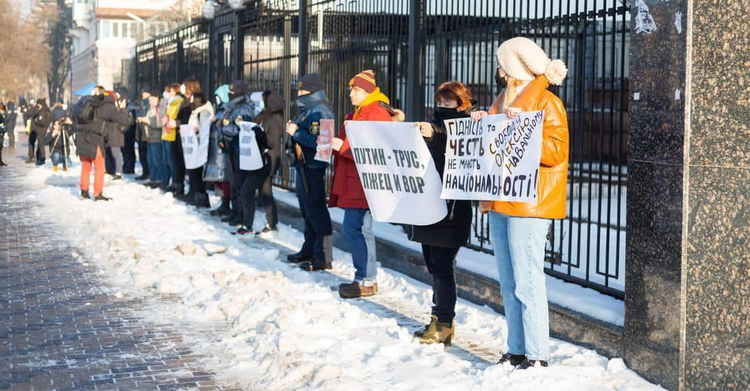Paul Mason finds the democratic world in the very disarray the authoritarian in the Kremlin has sought.

Do you want to go to war with Russia over Ukraine? You wouldn’t have to go yourself, but you would have to approve sending tens of thousands of young Europeans and Americans to deploy on chilly wheatfields last fought over by the Red Army and the Wehrmacht.
The best outcome would be that Ukraine remained a western-oriented, oligarchic-capitalist country with a fragile democracy but that what’s left of the geopolitical architecture would disintegrate. The worst would be nuclear confrontation.
So do you want to start a war over Ukraine? Thought not.
Yet this month the British prime minister, Boris Johnson, placed 600 paratroops, plus an unspecified number of special-forces troops, on high alert to deploy to Ukraine. The Central Intelligence Agency boss, William Burns, felt he had to fly to Moscow to warn the Russian president, Vladimir Putin, not to invade the country, while his United States counterpart, Joe Biden, reiterated America’s ‘unwavering support for the sovereignty and territorial integrity of Ukraine’.
Russia has assembled 92,000 troops on Ukraine’s north-eastern border. It has thereby signalled—for the second time this year—its capability to invade, seize the Black Sea coast to Odessa and cancel out the sovereignty of a nation.
Deflecting attention
Security analysts say the crisis on the European Union’s margins, triggered by Belarus ferrying refugees to the Polish and Lithuanian borders—leaving them to freeze—is a classic ‘distraction manouvre’. It is designed simultaneously to sow division within the North Atlantic Treaty Organization and the EU (succeeding there) and to deflect attention from Putin’s main effort, the military intimidation of Ukraine.
There is a growing belief in western security circles that Putin wants to force the US and its European allies to accept a new, formal, ‘great power’ system, as in cold-war times. This would entail treating as unchallengeable Russia’s influence in the former territories of the Soviet Union, ending sanctions on the country and Belarus, and withdrawing western ‘soft power’ support from democratic oppositions.
Andrea Kendall-Taylor, a former senior US intelligence officer and Russia expert at the Center for a New American Security, told a seminar this month: ‘The rhetoric in the Kremlin has really changed … It used to be no NATO membership for Ukraine. But now it’s no NATO infrastructure, so [Putin] is changing what he considers his red lines.’
Putin’s endgame—clear since the essay in which he outlined Ukraine’s future role as a vassal state—is a ‘soft federation’ between the two countries and an end to the western orientation and associated influence there. Since the flurry of western concern is combined with studied inaction, he might feel emboldened towards that goal.
Weakness and fragmentation
If so, what are the implications for the EU, NATO and the United Kingdom?
The Belarus crisis has already demonstrated the political weakness and fragmentation of Europe. By declaring a state of emergency at its border, Poland was able, in defiance of humanitarian law, to exclude journalists and criminalise humanitarian-aid workers—and indeed locals—trying to offer assistance to those refugees who made it through the fence.
The Law and Justice (PiS) government in Poland—already at odds with the European Commission and the Court of Justice of the EU over the rule of law—chose to exclude the EU external-security agency, Frontex, from the policing of the tense border situation. Instead it drafted in a contingent of British army engineers to strengthen its border defences.
Britain has around 80 armoured reconnaissance troops in the country, as part of NATO’s ‘enhanced forward presence’ in the Baltic region. But the engineers sent to the border arrived courtesy of a bilateral arrangement between London and Warsaw. The PiS leader, Jarosław Kaczyński, thus used an ad hoc alliance with the UK to bypass the architecture of NATO and the EU.
In Germany, meanwhile, the outgoing chancellor, Angela Merkel, broke the diplomatic isolation of the regime of Alyaksandr Lukashenka by staging her own bilateral initiative—two phonecalls with the Belarus dictator in which they reportedly discussed creating a humanitarian corridor for the refugees. With the formation of a coalition in Berlin led by the social democrats now imminent, there will be even less appetite for a strategy of confrontation with Putin.
Severe bind
This, in turn, has placed the Biden administration in a severe bind. It had increased the tempo of US exercises in the Black Sea and begun to supply portable anti-tank and anti-aircraft missiles to Kyiv. It could respond to the growing tension by supplying bigger and more numerous weapons and more excercises—or it could effectively back off, citing in justification the irresolution and division among its European allies.
We are, in short, at a crossroads in western thinking about Ukraine and the Black Sea region. Hawks in Washington argue that to rule out forever NATO membership for Ukraine would be to deny its sovereignty. But this might also be a recognition of reality.
I am no fan of Putin. Russia has been waging hybrid warfare against our democracies and seeking to weaken our security alliances in a multi-dimensional space. NATO, with its mutual-defence pact, and the EU are vital parts of the global security architecture.
Yet I cannot see any popular support, in any western democracy with military capabilities, for a confrontation with Putin over Ukraine—let alone for the implied outcome, a shooting war.
Weakening position
The agony for the Biden administration is that, despite its intent to face down Russia over the threats to Ukraine, every move it makes seems to weaken its position. It sends Javelin and Stinger missiles to Ukraine to deter aggression; Putin identifies the act as aggression in itself. It talks tough about Ukraine as a NATO ally; Putin and Lukashenka use hybrid warfare—from the refugee crisis to restricted energy supplies—to demonstrate that NATO remains irresolute and divided.
Worse, if western leaders did throw in the towel over Ukraine, they know there is a chance that Russian hybrid aggression—the electoral manipulation, disinformation, cyber-attacks and organised crime—might simply switch to the next target: Estonia, Finland, Bosnia-Herzegovina or Moldova. And the whole episode might then be used by China’s ruler, Xi Jinping, as the playbook for the forced reincorporation of Taiwan, following suppression of the relative autonomy Hong Kong once enjoyed.
There are many in Washington, and some in Europe, who believe it was a mistake, after the fall of the Berlin wall and the collapse of the Warsaw Treaty Organization under Soviet tutelage, to expand NATO right up to Russia’s border. But the move is now irrevocable. It may be better for the west to stabilise what exists, to reach a diplomatic compromise replacing the ‘Normandy Format’—a peace deal after the conflict in eastern Ukraine, which Putin has rendered defunct—with a more permanent, US-EU-Russia treaty.
Freedom and democracy
What is impossible to ignore are the growing demands among young people in Russia, Belarus and the other ex-Soviet satellite states for greater freedom and democracy. And what the oligarchs around Putin fear most is a new wave of ‘colour revolutions’—such as the ‘orange revolution’ in Ukraine—which would destroy the semi-criminal state structures that protect them, from Minsk to Moscow to Tbilisi.
Since Barack Obama was elected president in 2008, however, no US leader, or major European politician, has placed any significant emphasis on actively supporting democratic oppositions east of the River Bug. That is a reflection of the fragility of western democracy itself: after the attempted constitutional coup in January by Biden’s predecessor, Donald Trump, and with far-right candidates vying for second slot in the French presidential election of 2022, sorting out other people’s political systems looks to many reluctant realists like a luxury the west no longer enjoys.
If the west does climb down in the current stand-off, it should however learn lessons that strengthen the defences—civil and military—of liberal democracies against the manipulation taking place. The biggest service we could do ourselves is to display honesty.
The question I posed at the start of this column is not theoretical. It is being weighed actively by military planners and the security apparatus of major NATO states. If it were posed as bluntly and publicly as I do to the wider electorate, it would be resoundingly answered in the negative.
How we got ourselves into such a situation is the question those who have held power over the past 20 years should be asking themselves.
This is a joint publication by Social Europe and IPS-Journal
Paul Mason is a journalist, writer and filmmaker. His latest book is How To Stop Fascism: History, Ideology, Resistance (Allen Lane). His most recent films include R is For Rosa, with the Rosa Luxemburg Stiftung. He writes weekly for New Statesman and contributes to Der Freitag and Le Monde Diplomatique.
